fuel pressure VAUXHALL ADAM 2015 Owner's Manual
[x] Cancel search | Manufacturer: VAUXHALL, Model Year: 2015, Model line: ADAM, Model: VAUXHALL ADAM 2015Pages: 225, PDF Size: 6.81 MB
Page 90 of 225
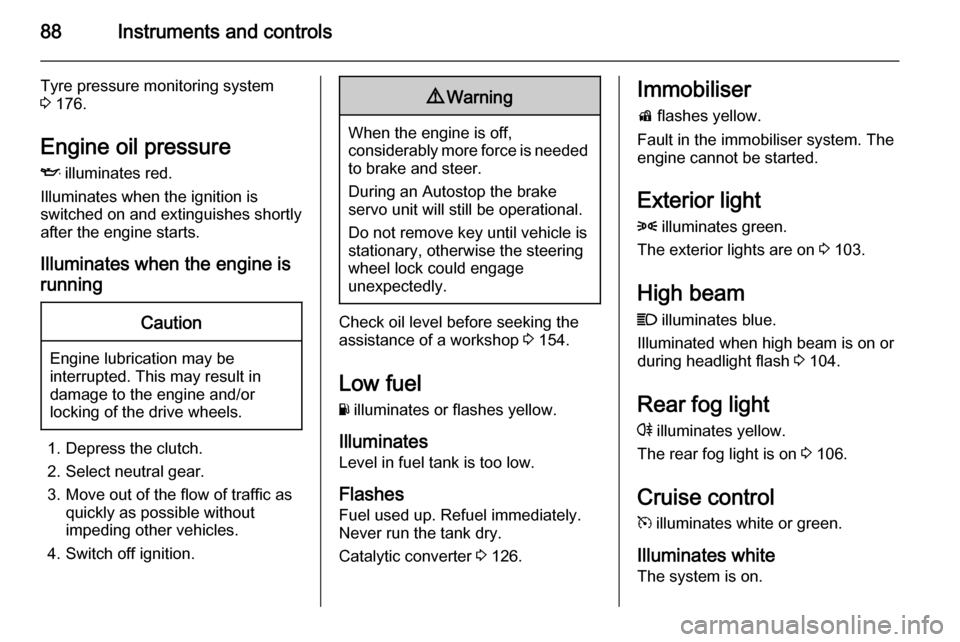
88Instruments and controls
Tyre pressure monitoring system
3 176.
Engine oil pressure
I illuminates red.
Illuminates when the ignition is
switched on and extinguishes shortly
after the engine starts.
Illuminates when the engine isrunningCaution
Engine lubrication may be
interrupted. This may result in
damage to the engine and/or
locking of the drive wheels.
1. Depress the clutch.
2. Select neutral gear.
3. Move out of the flow of traffic as quickly as possible without
impeding other vehicles.
4. Switch off ignition.
9 Warning
When the engine is off,
considerably more force is needed
to brake and steer.
During an Autostop the brake
servo unit will still be operational.
Do not remove key until vehicle is stationary, otherwise the steeringwheel lock could engage
unexpectedly.
Check oil level before seeking the
assistance of a workshop 3 154.
Low fuel
Y illuminates or flashes yellow.
Illuminates
Level in fuel tank is too low.
Flashes Fuel used up. Refuel immediately.
Never run the tank dry.
Catalytic converter 3 126.
Immobiliser
d flashes yellow.
Fault in the immobiliser system. The
engine cannot be started.
Exterior light8 illuminates green.
The exterior lights are on 3 103.
High beam
C illuminates blue.
Illuminated when high beam is on or
during headlight flash 3 104.
Rear fog light
r illuminates yellow.
The rear fog light is on 3 106.
Cruise control m illuminates white or green.
Illuminates white The system is on.
Page 92 of 225
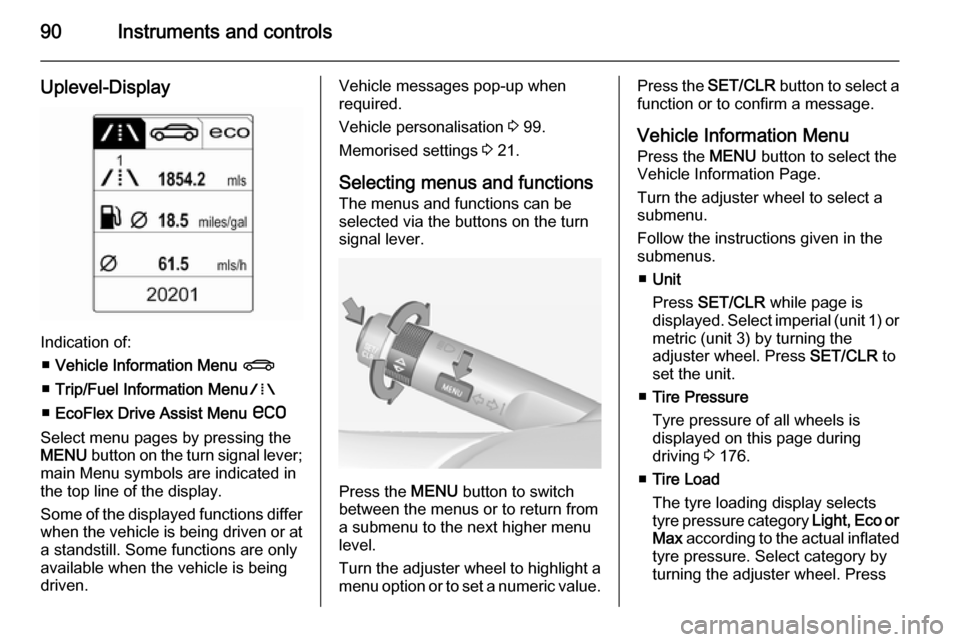
90Instruments and controls
Uplevel-Display
Indication of:■ Vehicle Information Menu X
■ Trip/Fuel Information Menu W
■ EcoFlex Drive Assist Menu s
Select menu pages by pressing the
MENU button on the turn signal lever;
main Menu symbols are indicated in
the top line of the display.
Some of the displayed functions differ when the vehicle is being driven or at
a standstill. Some functions are only
available when the vehicle is being
driven.
Vehicle messages pop-up when
required.
Vehicle personalisation 3 99.
Memorised settings 3 21.
Selecting menus and functions
The menus and functions can be selected via the buttons on the turnsignal lever.
Press the MENU button to switch
between the menus or to return from
a submenu to the next higher menu
level.
Turn the adjuster wheel to highlight a
menu option or to set a numeric value.
Press the SET/CLR button to select a
function or to confirm a message.
Vehicle Information Menu
Press the MENU button to select the
Vehicle Information Page.
Turn the adjuster wheel to select a
submenu.
Follow the instructions given in the submenus.
■ Unit
Press SET/CLR while page is
displayed. Select imperial (unit 1) or metric (unit 3) by turning the
adjuster wheel. Press SET/CLR to
set the unit.
■ Tire Pressure
Tyre pressure of all wheels is
displayed on this page during
driving 3 176.
■ Tire Load
The tyre loading display selects tyre pressure category Light, Eco or
Max according to the actual inflated
tyre pressure. Select category by
turning the adjuster wheel. Press
Page 148 of 225
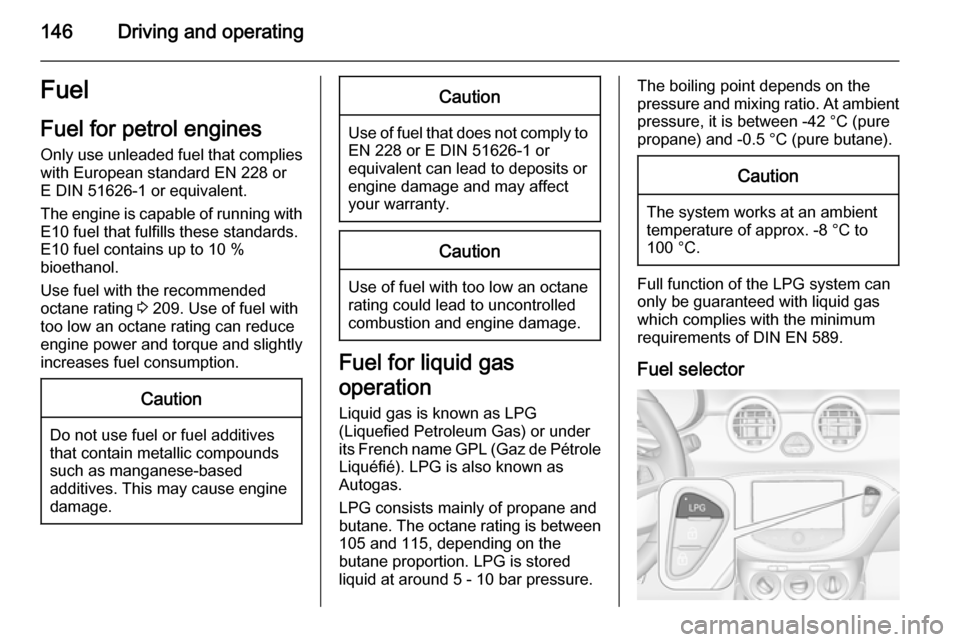
146Driving and operatingFuel
Fuel for petrol engines Only use unleaded fuel that complies
with European standard EN 228 or E DIN 51626-1 or equivalent.
The engine is capable of running with E10 fuel that fulfills these standards.
E10 fuel contains up to 10 %
bioethanol.
Use fuel with the recommended
octane rating 3 209. Use of fuel with
too low an octane rating can reduce engine power and torque and slightly
increases fuel consumption.Caution
Do not use fuel or fuel additives
that contain metallic compounds
such as manganese-based
additives. This may cause engine
damage.
Caution
Use of fuel that does not comply to EN 228 or E DIN 51626-1 or
equivalent can lead to deposits or
engine damage and may affect
your warranty.
Caution
Use of fuel with too low an octane
rating could lead to uncontrolled combustion and engine damage.
Fuel for liquid gas
operation Liquid gas is known as LPG
(Liquefied Petroleum Gas) or under
its French name GPL (Gaz de Pétrole Liquéfié). LPG is also known as
Autogas.
LPG consists mainly of propane and
butane. The octane rating is between
105 and 115, depending on the
butane proportion. LPG is stored
liquid at around 5 - 10 bar pressure.
The boiling point depends on the
pressure and mixing ratio. At ambient
pressure, it is between -42 °C (pure
propane) and -0.5 °C (pure butane).Caution
The system works at an ambient
temperature of approx. -8 °C to
100 °C.
Full function of the LPG system can
only be guaranteed with liquid gas
which complies with the minimum
requirements of DIN EN 589.
Fuel selector
Page 154 of 225
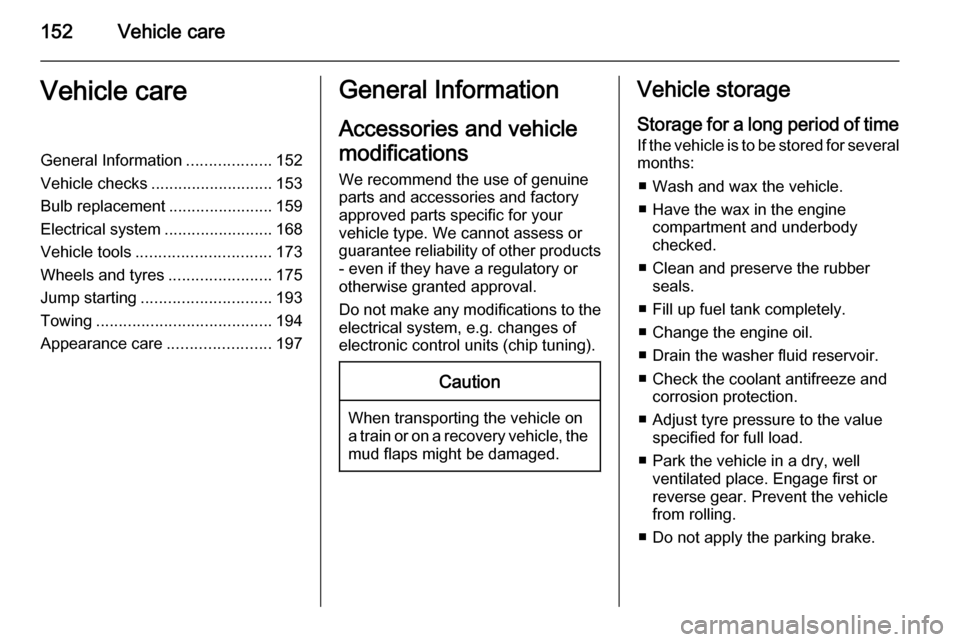
152Vehicle careVehicle careGeneral Information...................152
Vehicle checks ........................... 153
Bulb replacement .......................159
Electrical system ........................168
Vehicle tools .............................. 173
Wheels and tyres .......................175
Jump starting ............................. 193
Towing ....................................... 194
Appearance care .......................197General Information
Accessories and vehicle
modifications
We recommend the use of genuine parts and accessories and factory
approved parts specific for your
vehicle type. We cannot assess or
guarantee reliability of other products
- even if they have a regulatory or
otherwise granted approval.
Do not make any modifications to the electrical system, e.g. changes of
electronic control units (chip tuning).Caution
When transporting the vehicle on
a train or on a recovery vehicle, the
mud flaps might be damaged.
Vehicle storage
Storage for a long period of time
If the vehicle is to be stored for several months:
■ Wash and wax the vehicle.
■ Have the wax in the engine compartment and underbody
checked.
■ Clean and preserve the rubber seals.
■ Fill up fuel tank completely.
■ Change the engine oil.
■ Drain the washer fluid reservoir.
■ Check the coolant antifreeze and corrosion protection.
■ Adjust tyre pressure to the value specified for full load.
■ Park the vehicle in a dry, well ventilated place. Engage first orreverse gear. Prevent the vehiclefrom rolling.
■ Do not apply the parking brake.
Page 178 of 225
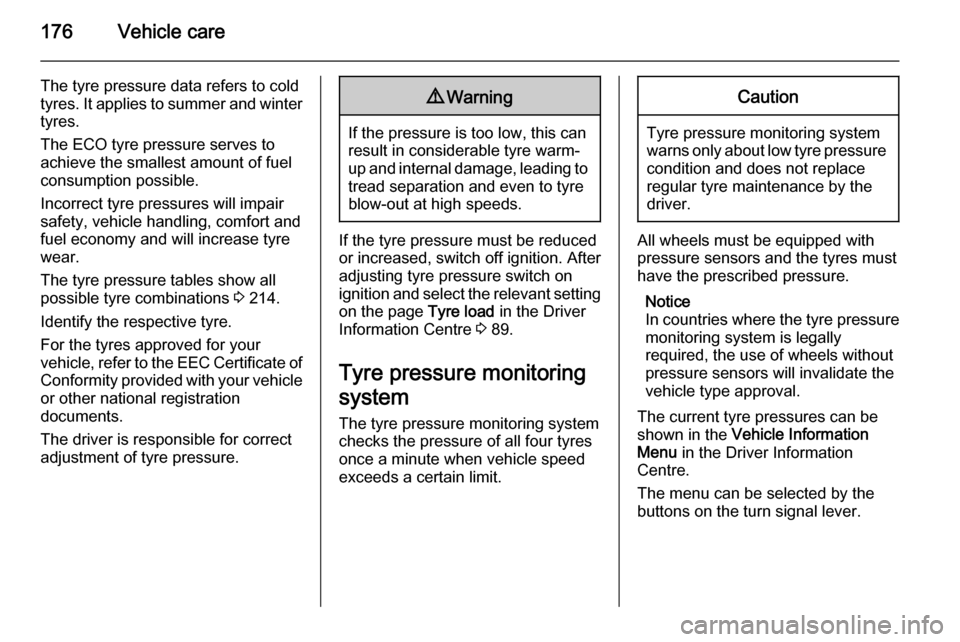
176Vehicle care
The tyre pressure data refers to cold
tyres. It applies to summer and winter tyres.
The ECO tyre pressure serves to
achieve the smallest amount of fuel
consumption possible.
Incorrect tyre pressures will impair
safety, vehicle handling, comfort and fuel economy and will increase tyre
wear.
The tyre pressure tables show all
possible tyre combinations 3 214.
Identify the respective tyre. For the tyres approved for your
vehicle, refer to the EEC Certificate of Conformity provided with your vehicle
or other national registration
documents.
The driver is responsible for correct
adjustment of tyre pressure.9 Warning
If the pressure is too low, this can
result in considerable tyre warm-
up and internal damage, leading to tread separation and even to tyre
blow-out at high speeds.
If the tyre pressure must be reduced
or increased, switch off ignition. After
adjusting tyre pressure switch on
ignition and select the relevant setting
on the page Tyre load in the Driver
Information Centre 3 89.
Tyre pressure monitoring
system The tyre pressure monitoring system
checks the pressure of all four tyres
once a minute when vehicle speed
exceeds a certain limit.
Caution
Tyre pressure monitoring system
warns only about low tyre pressure condition and does not replace
regular tyre maintenance by the
driver.
All wheels must be equipped with pressure sensors and the tyres must
have the prescribed pressure.
Notice
In countries where the tyre pressure
monitoring system is legally
required, the use of wheels without
pressure sensors will invalidate the
vehicle type approval.
The current tyre pressures can be
shown in the Vehicle Information
Menu in the Driver Information
Centre.
The menu can be selected by the buttons on the turn signal lever.
Page 201 of 225
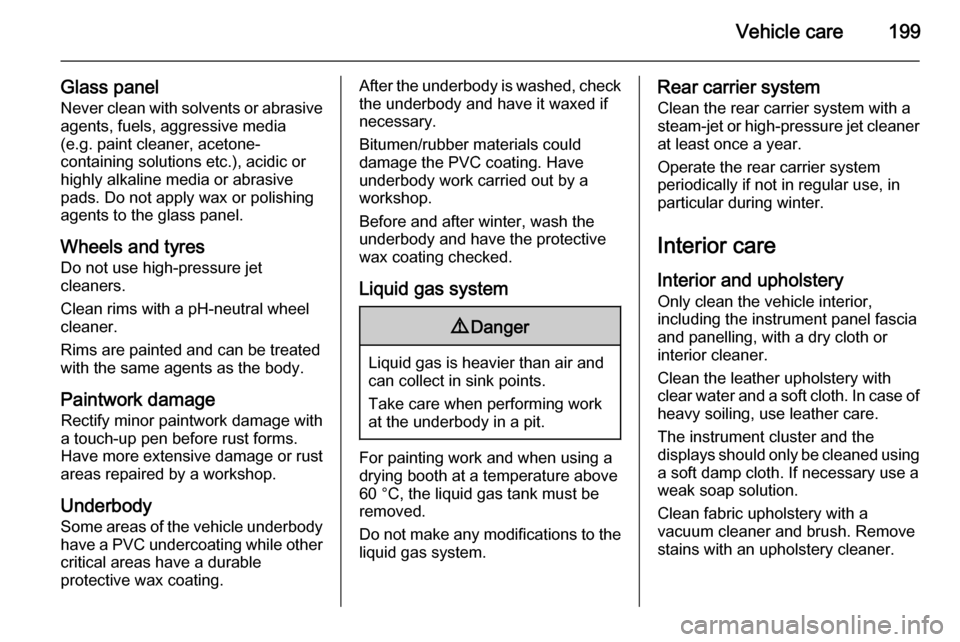
Vehicle care199
Glass panel
Never clean with solvents or abrasive
agents, fuels, aggressive media
(e.g. paint cleaner, acetone-
containing solutions etc.), acidic or
highly alkaline media or abrasive
pads. Do not apply wax or polishing
agents to the glass panel.
Wheels and tyres Do not use high-pressure jet
cleaners.
Clean rims with a pH-neutral wheel
cleaner.
Rims are painted and can be treated
with the same agents as the body.
Paintwork damageRectify minor paintwork damage with
a touch-up pen before rust forms.
Have more extensive damage or rust
areas repaired by a workshop.
Underbody
Some areas of the vehicle underbody
have a PVC undercoating while other critical areas have a durable
protective wax coating.After the underbody is washed, check
the underbody and have it waxed if
necessary.
Bitumen/rubber materials could
damage the PVC coating. Have
underbody work carried out by a
workshop.
Before and after winter, wash the
underbody and have the protective
wax coating checked.
Liquid gas system9 Danger
Liquid gas is heavier than air and
can collect in sink points.
Take care when performing work
at the underbody in a pit.
For painting work and when using a
drying booth at a temperature above
60 °C, the liquid gas tank must be
removed.
Do not make any modifications to the
liquid gas system.
Rear carrier system
Clean the rear carrier system with a
steam-jet or high-pressure jet cleaner
at least once a year.
Operate the rear carrier system
periodically if not in regular use, in
particular during winter.
Interior care
Interior and upholstery Only clean the vehicle interior,
including the instrument panel fascia
and panelling, with a dry cloth or
interior cleaner.
Clean the leather upholstery with
clear water and a soft cloth. In case of heavy soiling, use leather care.
The instrument cluster and the
displays should only be cleaned using
a soft damp cloth. If necessary use a
weak soap solution.
Clean fabric upholstery with a
vacuum cleaner and brush. Remove
stains with an upholstery cleaner.
Page 221 of 225

219
Coolant and antifreeze...............202
Cruise control ...................... 88, 132
Cupholders .................................. 52
Curtain airbag system .................. 43
D Danger, Warnings and Cautions ...4
Daytime running lights ...............105
Declaration of conformity ............215
Door open .................................... 89
Doors ............................................ 24
Driver assistance systems ..........132
Driver Information Centre .............89
Driving hints ................................ 121
E
Electric adjustment ......................27
Electrical system......................... 168
Electronic climate control system 114
Electronic Stability Control.......... 130
Electronic Stability Control and Traction Control system ............87
End-of-life vehicle recovery .......153
Engine compartment fuse box ...169
Engine coolant ........................... 155
Engine coolant temperature gauge ....................................... 80
Engine data ............................... 209
Engine exhaust .......................... 126
Engine identification ...................205Engine oil ................... 154, 202, 206
Engine oil pressure ......................88
Entry lighting .............................. 109
Event data recorders ..................216
Exit lighting ................................ 109
Exterior care .............................. 197
Exterior light ................................. 88
Exterior lighting ....................12, 103
Exterior mirrors ............................. 27
F
First aid ......................................... 68
First aid kit ................................... 68
Fixed air vents ........................... 119
Flex-Fix system ............................ 54
Folding mirrors ............................. 27
Front airbag system .....................42
Front seats.................................... 33
Front storage ................................ 53
Front turn signal lights ...............162
Fuel............................................. 146
Fuel consumption - CO 2-
Emissions ............................... 151
Fuel for liquid gas operation .......146
Fuel for petrol engines ...............146
Fuel gauge ................................... 80
Fuel selector ................................ 80
Fuses ......................................... 168G
Gauges ......................................... 79
Glass panel .................................. 31
Glovebox ..................................... 52
Graphic-Info-Display .....................95
H Halogen headlights ....................159
Hand brake ......................... 127, 128
Hazard warning flashers ............105
Headlight flash ........................... 104
Headlight range adjustment ......105
Headlights................................... 103
Headlights when driving abroad 105
Head restraint adjustment .............8
Head restraints ............................ 32
Heated mirrors ............................. 27
Heated rear window ..................... 30
Heated steering wheel .................72
Heating ........................................ 36
Heating and ventilation system . 111
High beam ........................... 88, 104
Hill start assist ........................... 129
Horn ....................................... 13, 72
I
Identification plate .....................205
Ignition switch positions .............122
Immobiliser ............................ 26, 88
Indicators ...................................... 79